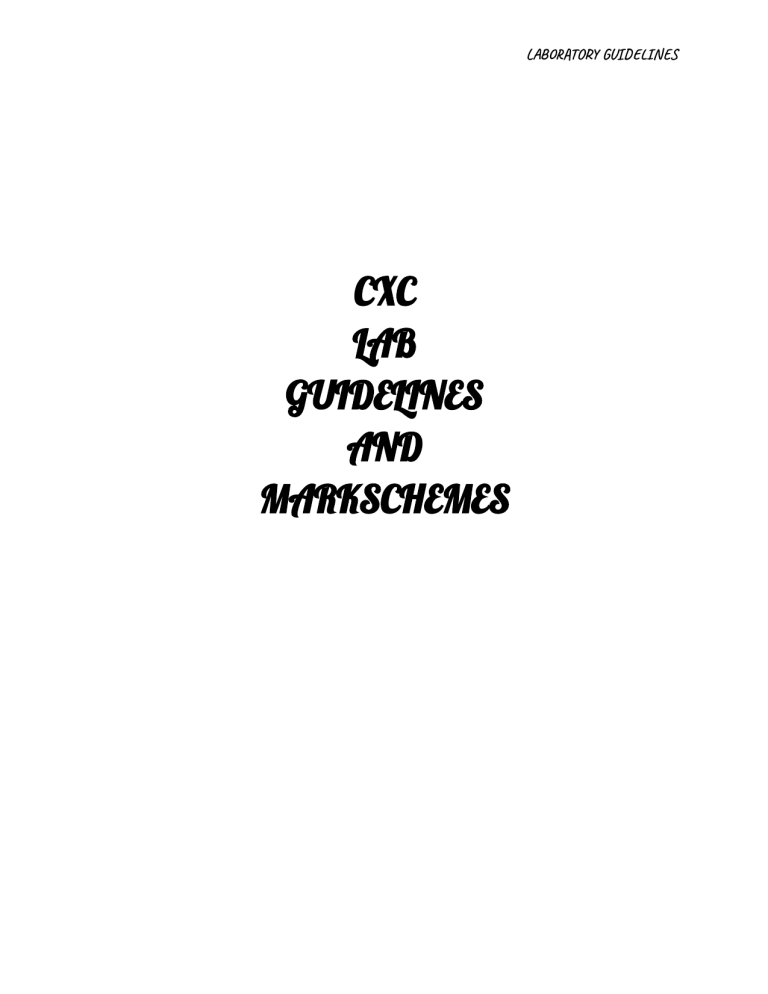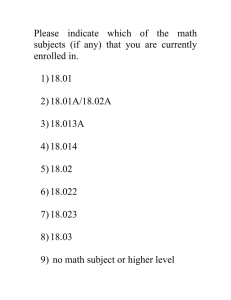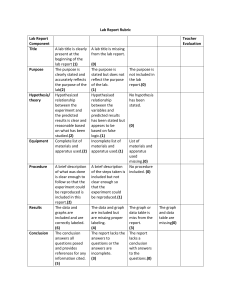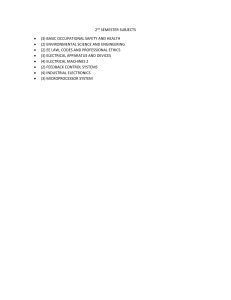
LABORATORY GUIDELINES CXC LAB GUIDELINES AND MARKSCHEMES LABORATORY GUIDELINES MANIPULATION/MEASUREMENTS Aim: - set up, use carefully and competently simple laboratory apparatus and measuring instruments; - appropriately prepare materials for observation/investigation; - master separation techniques; - use materials economically; Measurement and Manipulation (MM) develop student’s ability to: (a) Handle scientific equipment competently. The list of equipment includes: (i) Bunsen burner; (ii) measuring cylinder; (iii) beakers; (iv) thermometer; (v) ruler; (vi) stopwatch/clock; (vii) balance; (viii) boiling tube; (ix) burette; (x) pipette; (xi) conical flask; (xii) syringe; (xiii) voltmeter; (xiv) ammeter. This list is not exhaustive. (b) Use of appropriate apparatus. (c) Take accurate measurements. OBSERVATION/REPORTING/RECORDING (ORR) Observation/Recording/ Reporting - use the senses and extensions of them to perceive objects and events accurately; - present a written report, drawing or other graphical representation, which is clear, concise, accurate and pertinent to the investigation; - report and recheck unexpected results; - Drawing make large, clear, labeled line representations of apparatus or models; Develop student’s ability to: (a) Recording Student’s ability to record observations and to collect and organize data. Observations and data may be recorded in the following format. (i) Prose Written description of observations in the correct tense. (ii) Table (Neatly enclosed) - Numerical: physical quantities in heading, correct units stated in heading, symbols, decimal points. - Non-numerical: headings correct, details present. (iii) Graph: - Axes labeled with units, - correct scales, - correct plotting, LABORATORY GUIDELINES - smooth curves/best fit lines. (iv) Drawing of apparatus as set up for use. (b) Reporting Student’s ability to prepare a comprehensive written report on their assignments using the following format: (i) Date (date of experiment). (ii) Aim (what is the reason for doing the experiment). (iii) Apparatus and Materials (all equipment, chemicals and materials used in the experiment must be listed). (iv) Method/Experimental Procedure (step-by-step procedure written in the past tense, passive voice). (v) Results and Observations (see (a) above: Recording). (vi) Discussion and Conclusion (see 4: ANALYSIS AND INTERPRETATION Analysis and Interpretation Student’s ability to: (a) identify patterns and trends; (b) make accurate calculations; (c) identify limitations and sources of error; (d) make a conclusion to either support or refute the hypothesis; (e) compare actual results with expected results if they are different; (f) suggest alternative methods or modifications to existing methods; (g) analyse and interpret results and observations, (h) and make conclusions. PLANNING AND DESIGNING Aim: - develop hypotheses and devise means of carrying out investigations to test them; - plan experimental procedures and operations in appropriate sequence; - identify variables, - state expected results, - identify precautions and possible sources of error. It is expected that some of the planning and designing activities will be carried out to help students develop this skill. However, the reports of these activities are no longer plans and cannot be assessed as Planning and Design. They can be marked for other skills, for example, ORR. Student’s ability to: - (a) Ask questions: how, what, which, why or where. (Students must be guided by their teachers to ask scientific questions based on a stated problem). Sample Problem: It has been observed that galvanized roofs on beach houses corrode faster than those on houses LABORATORY GUIDELINES - inland. Example: Why do galvanized roofs on beach houses corrode faster than those on houses inland? (b) Construct a hypothesis; the hypothesis must be clear, concise and testable. Example: Iron rusts faster in the presence of salt water. (c) Design an experiment to test the hypothesis Experimental reports must include the following: (i) problem statement; (ii) aim; (iii) list of materials and apparatus to be used; (iv) clear and concise step by step procedure; (v) manipulated and responding variables; (vi) controlled variables; (vii) observations to be made or measurements to be taken; (viii) suggested display of results(for example, graphs tables ; (ix) proposed use of results; (x) possible limitations, assumptions; (xi) precautions to be taken. LABORATORY GUIDELINES Experiment 12 Skill: MM and ORR Title: Rates of Reaction Aim: To determine the effect of concentration on the rate of reaction CRITERIA MM MARKS 10 1. - Handle scientific equipment competently. Reads measuring cylinder at eye level Measuring cylinder is on flat surface Reads bottom of the meniscus Use of beakers; pours without spillage stopwatch/clock; starts clock on time, stops when cross disappears 2. 3. 4. - Use of appropriate apparatus for measuring Use accurate volumes Equipment handling Labels correctly stoppers replaced promptly ORR 1 1 1 1 2 1 1 1 1 40 1. Observations - in the correct tense. - Color change: 1 1 2. - 1 1 1 1 1 Table Neatly enclosed Consistent decimal places Title self-explanatory, details present Headings appropriate with correct units/symbols 1/T values are correct to 2 d.p. LABORATORY GUIDELINES 3. Graph - Title Self explanatory and gives details of graph - Axes labeled with units volume on y and time on x - correct scales, Graph occupies more than 75% of the paper [2] Graph occupies more than 50% of the paper [1] Graph occupies less than 50% of the paper [0] - correct plotting, All points plotted correctly [2] 1-2 points plotted incorrectly [1] More than 2 points plotted incorrectly [0] - smooth curves/line of best fit 8 marks each graph Scaled down to 4 marks each 1 1 1 Total 2 Total 2 1 4. Diagram of Apparatus - Drawing of apparatus as set up for use. - enclosed - Title - Labeling to one side of apparatus - Neat lines used to draw and straight lines used to label 1 1 1 1 1 5. Reporting Student’s ability to prepare a comprehensive written report on their assignments using the following format: a) Headings are in correct sequence (date, title, aim, apparatus, materials, method, results/observations, discussion, conclusion) 1 b) Method/Experimental Procedure - Logical sequence - written in the past tense, passive voice, no pronouns 1 1 c) Discussion and Conclusion - Language and grammar no grammatical errors [2] 2 LABORATORY GUIDELINES Few grammatical errors [1] More than 3 grammatical errors [0] - Variables Manipulated volume of thiosulphate and water used Responding Time/rate Controlled volume of acid used - Balanced equation of experiment - Theory 01. Defines rate of a reaction, 02. Account for the disappearing of the cross relating to time and concentration of reagents 03. Why does conc affect rate? Reference to collision theory 04. Describe graphs 1 and 2 (1 sentence) 05. Identify slowest rate on graph and fastest rate - Conclusion reflects aim and states relation to occurrence in experiment Total As a Fraction of 10 3 1 2 2 2 2 2 1 50 LABORATORY GUIDELINES Experiment 12 Skill: PLANNING AND DESIGNING Title: Rates of Reaction The effect of temperature on the rate of reaction Problem statement: Three students had an aim of making a solution of sugar and water faster. They each argued that their solutions would dissolve faster based on the temperature selected. Student A used room temperature water, student B used hot water and student C used cold water. Plan and design an experiment to determine which student's sugar solution would have a faster rate of reaction. HYPOTHESIS (2) - Clearly stated 1 - Testable 1 AIM (1) - Related to hypothesis 1 MATERIALS AND APPARATUS (1) - Appropriate materials and apparatus 1 METHOD (5) - correct tense 1 - Suitable 2 - At least one manipulated 1 - or responding 1 VARIABLES (1) -Controlled variable stated 1 EXPECTED RESULTS (3) - Reasonable 1 - one sentence 1 - Link with method 1 ASSUMPTIONS/PRECAUTIONS/POSSIBLE /SOURCES OF ERRORS (1) - Any one stated 1 TOTAL / 14 x 10 (10)


